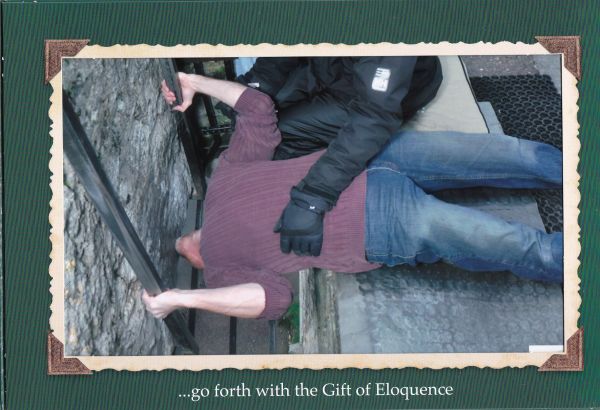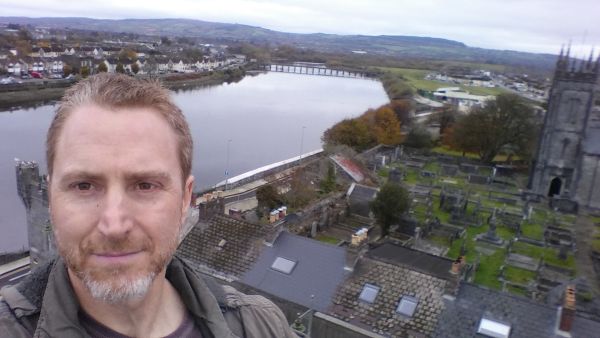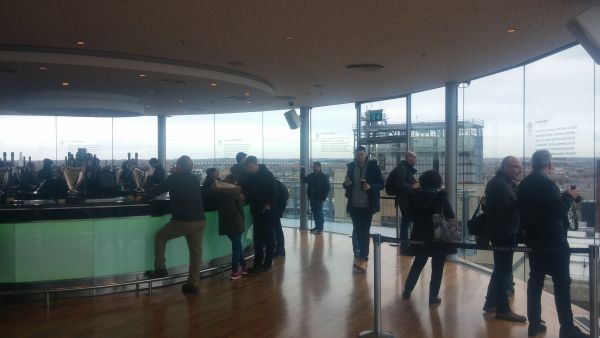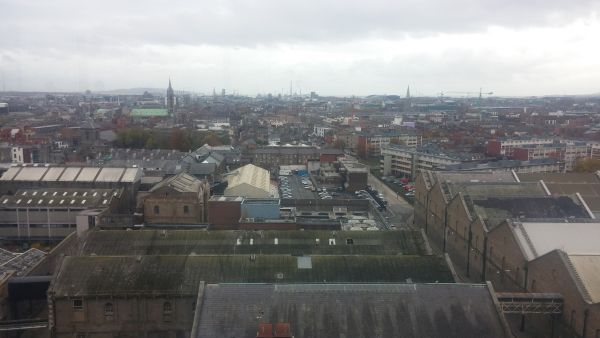Ireland 2018 |
| In the first week of November, Steffanie and I took a trip of a lifetime to Ireland. We got an awesome deal through Groupon that included airfare, a rental car, hotel, bed and breakfast, and several vouchers to castles and other attractions. It was too good to pass up! So we drove for a week around southern Ireland, from coast to coast, and had an amazing time. | ||
| Kilkenny Castle | ||
| Kilkenny Castle was built in 1195. It was probably the nicest and most well maintained of the castles we visited. This castle was transferred to the people of Kilkenny in the late 60s and is often used for awards and conferring ceremonies. | ||
| The table setting used real silver and was closely monitored. The guy who was giving the history of the dining room pointed out the sensors on the other side of the velvet ropes, and said the alarm will sound in the event of a breach. | ||
| It rains a lot in Ireland, which is why it's so green there. It truly is the emerald isle. As a precaution, I brought an umbrella with me on the tour this day. But we were very fortunate over the rest of the trip to not be hindered by rain during our visits to attractions. It mostly seemed to rain while we were enroute. | ||
| Blarney Castle | ||
| Two prior structures were built on the site of this castle. But the third and remaining castle was built in 1446. | ||
| When visiting Blarney Castle, one must climb to the top of this 90' structure by means of winding, uneven and narrow staircases and kiss the Blarney Stone. | ||
| The stone is set in the wall below the battlements. To kiss it you must lie on your back, reach out to two verticall bars, slide your hands down the bars and pull your face towards the stone. This is not an easy task, but luckily there is someone there to assist you, and another to take pictures. Years ago, visitors were held by their ankles to access it! | ||
 |
||
| The stone is a single block of bluestone, which is the same stone used in the construction of Stonehenge. There are many stories about the origin of the Blarney Stone. One claim is that Robert the Bruce presented part of this stone to Cormac McCarthy in 1314 as a gift from Scotland for their support in the Battle of Bannockburn. Another story claims that it is Jacob's pillow, brought by the prophet Jeremiah. The official Blarney website states that they believe a witch saved from drowning revealed its powers to the MacCarthys, and it was given as a gift for saving her life. | ||
| And no castle is complete without caves, a dungeon and a murder hole! Yes, this hole below is where an unsuspecting enemy intruder would have stones and boiling oil dropped on them. | ||
| Waterford | ||
| We stayed at the Viking Hotel in Waterford for the first two nights. So of course, we had to check out the Waterford Crystal store. We didn't take a tour of the factory, but did buy some souvenirs. | ||
| We did take a short stroll around the area, but it was getting late, cold and wet, so we got a couple of pictures and headed back to the hotel for the evening. This picture to the left is Reginald the Viking, founder of Waterford. | ||
| King John's Castle | ||
| This castle, built in 1200, is one of the best preserved to date. It was built along the Shannon River to protect Limerick from attacks by Norman lords. During the reign of King John, the city was so prosperous that he set up a mint in the castle. And to our delight, there was a penny press! Takes us back to our visit to San Francisco in 2009, before Steffanie's surgery. The boys wouldn't let us pass a penny press without pressing one out. | ||
 |
||
| A view from the top of the castle with the River Shannon behind me. | ||
| Years ago, houses were actually built within the castle courtyard. But once some archaeological finds were unearthed, the houses were removed and this area was excavated, revealing a new section below the courtyard grade. | ||
| Bunratty Castle | ||
|
Bunratty was our favorite castle. It was very authentic and almost felt as if you were stepping back into the 15th century. The main
part of the castle is three stories, with a lofty Great Hall on the second floor. At each corner of the castle is a tower with many
floors and chambers. Several of the bedrooms had connecting privies.
The castle was built in 1425, but is surrounded by a more modern folk park. The 19th century village includes a grocery store, hardware shop, post office and school. Some of the farmhouses have been relocated from rural areas. There are events held at the folk park such as school tours, winter festivals and medieval banquets. | ||
| I would've loved to have had more time here to tour the grounds, as there was so much to see. As we entered the village, we were welcomed by some goats and free-roaming chickens. Steffanie loved it! | ||
| Below is a picture of the Great Hall. This massive vaulted room is 47' high and has a 22' long, 10-legged table. In the 1950s, the castle was restored under the direction of Percy le Clerc. It was furnished with a collection of Lord Gort's furniture and tapestries. | ||
| The library was located on the top floor and had beautiful furnishings and ceiling architecture. It was a climb to get to this level, but had a great view of the property. | ||
| The Cliffs of Moher | ||
| Talk about breathtaking! The Cliffs of Moher rise almost 400' over the Atlantic Ocean, and are one of the most popular tourist attractions in Ireland. On average, they draw about 1.5 million tourists annually. | ||
| At the highest point of the cliffs sits O'Brien's Tower. This tower was built by landlord Sir Cornelius O'Brien in 1835 as an observation tower for Victorian tourists. | ||
| It's kind of hard to see in the picture above, but there is a walled pathway that was built several years ago along the cliff ledge as a safety for tourists. Our host at the bed and breakfast told us that local farmers who owned land along the cliffs got together and decided to give up a portion of their farmland to the pathway. The picture below shows a closer view of the wall. Sadly, many had lost their lives to the cliffs, and a memorial of bracelets adorns the wall to those who perished. | ||
| On our trip to the cliffs, it had rained off and on and then turned into a beautiful sunny afternoon. We had a nice treat after leaving the cliffs and saw a double rainbow! But did not find the pot of gold. | ||
| Poulnabrone Dolmen | ||
| Poulnabrone Dolmen was an interesting "off the beaten path" trek we took on our way back from the cliffs. It was late afternoon, just before dusk, so the colors and lighting in the backdrop were brilliant as the sun descended. Poulnabrone is a tomb constructed of large slabs of limestone. It is dated between 5,000 and 6,000 years old. During a 1985 excavation of the tomb, 33 people were discovered. It is believed that these people were buried elswhere prior to being relocated to the tomb, and may have all died in different time periods over several hundred years. | ||
| Leap Castle | ||
|
Leap Castle wasn't part of our tour package, but was a must-see for Steffanie, as it's been featured in several ghost hunting
shows over the years. It is believed to be the most haunted castle in Ireland. The owners, Sean Ryan and his wife, live in the
castle. Sean started renovating Leap Castle in 1994, and has done most of the work himself. He is a well known professional
musician of the tin whistle. He has toured the world and has even been to the Bloomington/Normal area!
When asked about the ghosts, Sean prefers to call them "spirits", and says they have as much of a right to be there as he does. Most of the time, Sean and his wife hear footsteps, disembodied voices and slamming doors. He will occasionally see partial to full apparitions and describes them as having a fuzzy glow around them. None of the activity is sinister in nature, and is described more as friendly and nonthreatening. | ||
| Shawn and his wife so graciously open their home to visitors, and ask a small fee, which is used for the continued renovations. | ||
| More of the fun winding stairs. These were actually a little easier to climb as the steps were a little deeper. We were climbing our way to the top to see the Bloody Chapel. The O'Carroll clan, who seized Leap Castle from the O'Bannons, were a ruthless and menacing clan. When no successor was left after the death of their chiefton, the two brothers were at odds with each other. One of the brothers was a priest and was performing mass in the chapel, when the other brother barged in and stabbed him to death. Hence the name Bloody Chapel. | ||
| Above, Steffanie is standing where the alter of the chapel would have been. To the right of the window, you can see the door to the oubliette. This is another disturbing feature of this castle. Oubliette is French and means "to forget". People were thrown into the oubliette dead or dying and were just left there. This was a form of a dungeon for the O'Carroll clan, and was one of many ways they disposed of their foes. Years later when the Darbys occupied the castle, the oubliette was cleaned out. It was said that three cartloads of skeletons were removed. | ||
| Before we left the castle, Sean entertained us by the fireplace with an Irish tune on his whistle. He is quite an astounding musician! | ||
| What made this even more of a special stop for Steffanie, was the friends she made outside the castle. There were at least five cats who greeted us when we arrived. But one was particularly friendly, and they became instant pals. | ||
| I even had a little trouble pulling her away from her new buddy to get a selfie of us in front of the castle. | ||
| Guinness Storehouse - Dublin | ||
| On our last full day, we had vouchers for three Dublin attractions. The Guinness Storehouse, Trinity College Book of Kells and Christ Church Cathedral. We thought we would start with Guinness since we don't drink, and thought we'd breeze through it quickly. We ended up spending almost half the day there! | ||
| The tour progresses up floor-by-floor. At the end of the tour, you can continue up to the Gravity Bar, which has a 360 degree view of Dublin. This was a nice opportunity to get a look around the city. | ||
 |
||
 |
||
| The storehouse was a neat place; kind of like a museum/tour/mini-mall/food court. We walked through the brewing process and had a taste in the tasting room. Then we ate lunch, bought some souvenirs and headed off to Trinity College. We ran out of time after seeing the Book of Kells, so missed seeing Christ Church Cathedral. There was no photgraphy allowed in the Book of Kells, so nothing to share on that. | ||
| We had a wonderful time touring Ireland. I've been telling everyone that it's as pretty as the pictures and movies portray it. An old world, rich with history. It really puts the young history of the U.S. into perspective. | ||
| One of the interesting things about Ireland were all of the old castles and ruins you would see just off the motorway (interstate). They are protected, and if you decide to purchase a castle for renovation, you are required to rebuild it using the original materials. Here were a couple of ruins we came across in our travels. Above is Leamaneh Castle, built in the 15th century by the O'Brien family. Below is Kilduff Castle in Limerick, which was built in the 16th century by the MacBrians. | ||